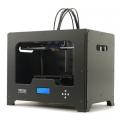Results 1 to 9 of 9
-
12-27-2015, 07:15 PM #1Student

- Join Date
- Dec 2015
- Posts
- 1
New to 3D printing: How to remove support material?
Hello community
I recently got a M3D for christmas and I have tested it out. I printed an airplane and I am sort of disappointed on how it turned out. The top part was fine but the bottom part of the wings was terrible. I could not get a smooth surface to save my life. How can I remove the support materiel in a way that will not hurt my print but get everything off.
-
12-28-2015, 01:18 AM #2
1) Use a soluble support material (requires a bit of sanding)
Or
2) Build and support material are the same (requires pliers, filing and sanding)
Or
3) Split the file into several smaller pieces that can be printed without support and then glued/cold-welded together.
-
12-28-2015, 01:21 AM #3
Most newcomers think that a 3D printed item will look like 'store bought'. This is not true. Depending on the look you want you will need to spend some time finishing your print by hand.
-
12-28-2015, 03:40 PM #4Staff Engineer

- Join Date
- Jan 2014
- Location
- Oakland, CA
- Posts
- 935
That's true of consumer-grade FFF printers; none of them seem to have worked out a soluble support system that's reliable (I'd love to be proved wrong about that). For industrial-quality FFF (FDM) machines like the Stratasys Dimension, soluble support has been standard for many years (no sanding required). Powderbed 3D printing processes don't require supports, since the piece is always supported by the powder. Photo-catalyzed resin printers do require support, but there can be a lot less of it than with FFF so cleanup is easier.
Andrew Werby
www.computersculpture.com
-
12-29-2015, 06:38 AM #5
Get a needle file set. These will help get the material off and smooth the print for you. I also use a cordless dremel with a rough and fine sanding drum. Peels that leftover support stub right off. Once it's nice and "not bumpy" any more, I'll do an Acetone (for ABS) vapor bath to finish the smoothing.
-
12-29-2015, 11:52 AM #6
-
12-29-2015, 03:11 PM #7
Sebastian, I'm envious, I'd love to have a machine that I won't assume the parts are out of spec. My Davinci usually requires some cleanup and alterations for most prints, but not enough to not do a project

-
12-29-2015, 05:16 PM #8Staff Engineer

- Join Date
- Jan 2014
- Location
- Oakland, CA
- Posts
- 935
[QUOTE=Sebastian Finke;76974]My client prototypes are often not sanded, especially if dimensional accuracy is required. My ABS/HIPS combination has worked very well in this regard.
That's good to hear! What dual-head machine are you using with those materials? I've heard that people have problems getting adhesion between the ABS and the HIPS, and difficulty getting the two heads synchronized on the same part. Does your printer have a heated build chamber? Do you use limonene to get the HIPS off, and what do you do with the stuff that's left over?
Andrew Werby
www.computersculpture.com
-
12-30-2015, 06:33 AM #9
I have an FFCX, nothing fancy. However it is calibrated perfectly and I have feeds and temps superbly tuned.
No issues with ABS/HIPS combination. Support density is usually between 40 and 60% although I have gone up to 75%. When using the two together I always use a raft.




 Reply With Quote
Reply With Quote






Extruder not feeding during print,...
Yesterday, 02:02 PM in Tips, Tricks and Tech Help